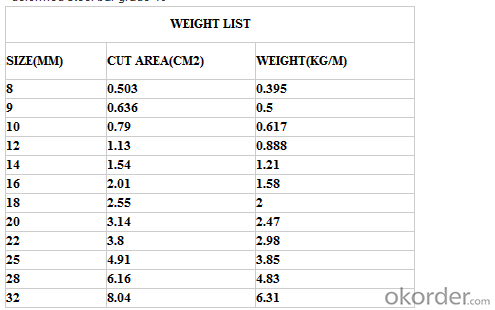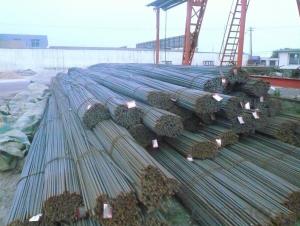Hot-Rolled Steel Deformed Bar,Rebar,Deformed Steel Bar
- Loading Port:
- Shanghai
- Payment Terms:
- TT OR LC
- Min Order Qty:
- 100 m.t.
- Supply Capability:
- 1000 m.t./month
OKorder Service Pledge
OKorder Financial Service
You Might Also Like
deformed steel bar grade 40
material: HRB400, BS4449 GR460B
size: 8-36mmx12m.
short delivery time by bulk or container
deformed steel bar grade 40
material: HRB400, BS4449 GR460B
size: 8-36mmx12m.
short delivery time with bulk or container
packing: Mill standard export packing in bundles/coil, around 2tons/bundle.
country of Origin: China
delivery Time: Within a 35 days
Shipment: by bulk vessel or by container

Leading goods:
section steel:angles,channels,I-beam,H-beam;
coils:cold/hot rolled coils,PPGI,galvanized coils,plate,checkered plate,cutting steel plate,steel strip;
wire rod:steel wire,deformed wire,bar;
pipe:seamless pipe,rectangular pipe,welded pipe,spiral welded pipe,pipe fittings;
stainless steel:steel sheets,stainless steel strips,stainless bar,stainless tube;
special:weathering steel,shipbuilding steel;
construction steel:C-channel,Z-channel,T-bar,high-speed divider plate,corrugated steel plate,steel grating.
Advantage:
We are the spot supplier, Six huge warehouses which can hold 20,000 MT goods.
It makes the cost lower than others,we can provide the competitive price for you.
Delivery time:
Normal sizes can be provided in 7days, the others should be ready in 30---45 days.
Further treatment:
We can offer cutting,painting,drilling holes,bending,threading, welding,galvanization,packing etc.
Security interest:
We have already passed the ISO9001, BV and SGS authentication which makes the quality secured.
If you have the interest in any of the products we can provided, pls don't hesitate to connect with me. Looking forward to cooperate with you.

FAQ of Steel Deformed Bar
1. More than 10 years experience in this industry
2. 100,000 tons exporting per month
3. Professional foreign trade tea
4. OEM&ODM capacity
5. High quality assured & competitive price
6. Try our best to meet your needs & save your budget
7. Very popular in Southeast Asia, Africa, Mid-East and South America etc.
8. VIP membership system, first time customers and long-term cooperation customers can get extra discount on some products.
- Q: How do steel rebars affect the durability of a concrete structure?
- Steel rebars greatly enhance the durability of a concrete structure by providing tensile strength and preventing cracks from forming. The rebars act as reinforcement by absorbing and distributing the stress caused by external forces, such as earthquakes or heavy loads, thereby ensuring the structure's stability and longevity.
- Q: What are the different types of steel rebars used in elevated highways?
- The different types of steel rebars used in elevated highways include carbon steel rebars, epoxy-coated rebars, galvanized rebars, and stainless steel rebars.
- Q: Can steel rebars be used in structures with high resistance to vibration?
- Yes, steel rebars can be used in structures with high resistance to vibration. Steel rebars are commonly used as reinforcement in concrete structures to increase their strength and durability. The use of steel rebars enhances the structural integrity of a building or infrastructure, making it more resistant to various forces, including vibrations. Steel rebars possess excellent tensile strength and stiffness, which allows them to absorb and distribute the applied loads evenly throughout the structure. This property helps to minimize localized stress concentrations that could lead to vibrations or structural failure. Additionally, steel rebars can effectively control the crack widths and prevent the propagation of cracks, further enhancing the structure's resistance to vibrations. Moreover, steel rebars can be designed to meet specific requirements based on the expected vibration levels. By utilizing rebars with appropriate diameters, spacing, and anchorage details, the structure can be engineered to withstand vibrations caused by various external factors, such as earthquakes, wind loads, or nearby machinery. It is crucial to ensure proper design and detailing of steel rebars in structures with high resistance to vibration. The reinforcement layout should be carefully planned to account for the anticipated forces and vibrations. Additionally, the rebars should be adequately anchored and connected to other structural members to maintain their effectiveness in resisting vibrations. Overall, steel rebars are a reliable and widely-used reinforcement material that can significantly enhance the resistance of structures to vibrations when designed and implemented correctly.
- Q: What are the common sizes of steel rebars used in construction?
- The common sizes of steel rebars used in construction vary depending on the specific application and engineering requirements. However, there are several standard sizes that are commonly used in the industry. The most frequently used rebar sizes range from #3 to #18. These numbers represent the diameter of the rebar in eighths of an inch. For example, a #3 rebar has a diameter of 3/8 inch, while a #18 rebar has a diameter of 2 1/4 inches. In terms of metric measurements, the most common rebar sizes range from 10mm to 40mm in diameter. These sizes are often designated by their nominal diameter in millimeters, such as 10mm, 12mm, 16mm, 20mm, 25mm, 32mm, and 40mm. The selection of the appropriate rebar size depends on factors such as the load-bearing capacity required, the structural design, and the type of construction project. Smaller diameter rebars, like #3 or 10mm, are typically used in lighter construction projects or for smaller concrete elements such as walls or slabs. On the other hand, larger diameter rebars, like #18 or 40mm, are commonly used in heavy-duty applications such as bridges, high-rise buildings, or large-scale infrastructure projects. It is important to note that different countries or regions may have their own specific standards for rebar sizes, so it is crucial to consult local building codes and regulations to ensure compliance.
- Q: What are the different methods of reinforcing concrete with steel rebars?
- There are several methods for reinforcing concrete with steel rebars. The most common method is to place the rebars in a grid pattern throughout the concrete structure. This can be done by tying the rebars together with wire or using rebar chairs to hold them in place. Another method is to use precast concrete elements with embedded rebars that are then connected together. Additionally, steel mesh or fiber reinforcement can be used to reinforce the concrete. These methods all help to improve the strength and durability of the concrete structure.
- Q: Can steel rebars be used in railway construction?
- Yes, steel rebars can be used in railway construction. Steel rebars are commonly used as reinforcement in concrete structures, including railway bridges, tunnels, and track foundations, to enhance their strength and durability.
- Q: How do steel rebars perform in extreme temperature conditions?
- Steel rebars perform well in extreme temperature conditions. Steel has a high melting point and thermal conductivity, allowing it to maintain its structural integrity even at elevated temperatures. Additionally, steel has a low coefficient of thermal expansion, reducing the risk of cracking or warping due to thermal stress. However, it is important to consider the specific grade and composition of the steel rebar, as certain alloys may exhibit different behavior in extreme temperatures.
- Q: What is the process of threading steel rebars?
- The process of threading steel rebars involves using a specialized machine to cut threads onto the ends of the rebars, which allows them to be easily connected together. This threading process enhances the structural integrity, stability, and overall strength of the rebars when used in construction projects.
- Q: Are there any limitations on the maximum length of steel rebars used in construction?
- Yes, there are limitations on the maximum length of steel rebars used in construction. The maximum length of steel rebars can vary depending on various factors such as the structural design, construction codes, and transportation limitations. In general, the length of steel rebars is limited by practical considerations such as handling, transportation, and installation. Very long rebars can be difficult to transport and maneuver on construction sites. Additionally, excessively long rebars may be more prone to bending or sagging, which can affect their structural integrity. Therefore, construction industry standards and codes typically provide guidelines or restrictions on the maximum length of steel rebars to ensure their safe and efficient use in construction projects. It is important for architects, engineers, and contractors to adhere to these limitations to ensure the structural stability and safety of the building.
- Q: Can steel rebars be used in reinforced masonry?
- Yes, steel rebars can be used in reinforced masonry. Reinforced masonry refers to the use of steel reinforcement within masonry walls, columns, or other structural elements to increase their strength and resistance to various forces. Steel rebars are commonly used as reinforcement in reinforced masonry due to their high tensile strength and ability to withstand bending and stretching forces. The rebars are typically embedded within the masonry units or mortar, creating a composite structure that can resist compressive, tensile, and shear forces more effectively. The use of steel rebars in reinforced masonry enhances the structural integrity, durability, and overall performance of the masonry construction, making it a widely accepted and practiced technique in the industry.
Send your message to us
Hot-Rolled Steel Deformed Bar,Rebar,Deformed Steel Bar
- Loading Port:
- Shanghai
- Payment Terms:
- TT OR LC
- Min Order Qty:
- 100 m.t.
- Supply Capability:
- 1000 m.t./month
OKorder Service Pledge
OKorder Financial Service
Similar products
Hot products
Hot Searches
Related keywords



























